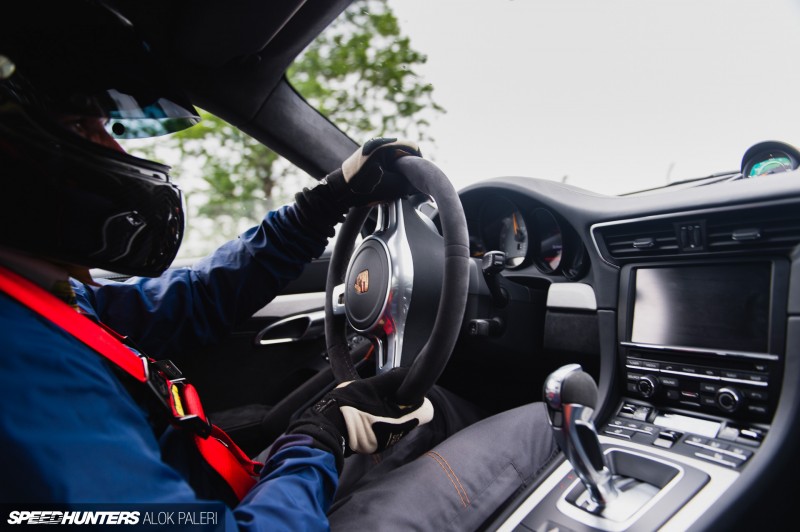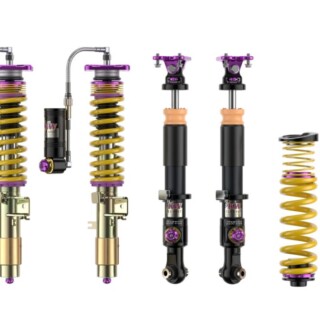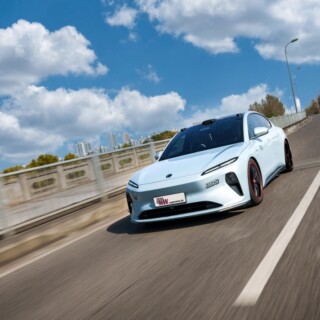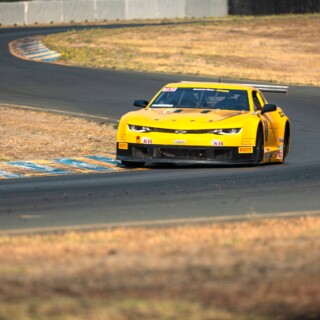
Our close friend Michael Grassl will take you on a Dream Drive … What’s your definition of a dream? For most people it’s the stories that occur in your mind while you sleep, and involve things that are far away from happening in real life. Here at Speedhunters, we aim to search out some of these dream scenarios – and actually experience them.

My name is Michael Grassl and I’m pretty new to the Speedhunters team. My job as a sales manager in the motorsport industry allows me to frequently get behind the wheel of performance street and race cars, so when I was asked to do what I love to do for this site – driving cars and talking about them – I just had to sign on.
Today, I want to take you on a ride in two cars that are quite similar in terms of shape, technique and even their respective names: the Porsche 991 GT3 and the Porsche 991 GT3 Cup. As these cars are definitely not designed for ice cream parlor racing, we chose a suitable environment for our comparison test – the Nürburgring Nordschleife, aka the Green Hell.

First, the hard facts. Both cars have 6-cylinder boxer engines, 380mm brake systems, Recaro seats, paddle shift gearboxes, rear wings and center-exit exhaust systems. But despite their similarities, each car has been designed for a completely different purpose. In saying that, it pays to keep in mind that there is no perfect car – only a perfect car for the requirements of its owner. In order to figure out the different thinking behind these cars, let’s take a look at them individually, starting with the all-white GT3 model year 2015.

Porsche’s GT3 street car is built for one purpose: hitting the track. And all of its factory-spec ingredients point to that fact.

The heart of the Porsche 991 GT3 is a 3.8-litre boxer six producing 476hp and 440Nm. Unfortunately, it hides behind plastic and carbon fiber covers, but trust me – it’s there once you turn the key!

Performance is not created by the engine itself – it’s the connection with the surface which is the more important issue. Our assistance here comes from 380mm brake units front and rear surrounded by 20×9-inch (front) and 20×12-inch (rear) center-lock wheels with Michelin Cup 2 tires in 245/35ZR20 and 305/30ZR20 respective sizing. Also in the game is Bilstein electronic adjustable coilovers, which offer two options: Comfort and Sport modes.

Wings – they’re the key fact for high-speed stability. Adjustable in multiple ways, the rear wing creates up to 30kg of downforce at 200km/h. That keeps the back end stable but also helps on high speed straights due to the side flaps.

Inside, the details read more like a race car: a rollcage in the back, perfect fitting Recaro seats and Schroth 6-point harnesses to keep the occupants locked in position.

The suede-wrapped steering wheel allows really precise direction changes, but more importantly it’s where you’ll find controls for the biggest difference this car has over previous GT-spec Porsche 911s. I’m talking about paddle shifters for the 7-speed PDK gearbox. This unit allows you to switch gears either manually or fully automatically.

Despite its factory looks, our test GT3 was not 100 per cent stock. The design and color of the exhaust end tips is the giveaway, and I’m sure that some of you out there will recognize the Slovenian flair that’s present. The full titanium Akrapovič Slip-On system not only reduces weight, but also amplifies the soundtrack. There’s only one other non-OE upgrade, and that’s the Endless brake pads.

Details aside, I was eager to get behind the wheel and sample the sum of all the GT3s parts in proper driving terms. In readying myself for the experience, there’s the required safety gear: helmet, gloves and a HANS device.

After adjusting the seat, harnesses and steering wheel, I fired up the GT3 and made my way to the track’s tourist entry gate. Now, it’s all on. The surface is dry and there are not too many other cars about – perfect conditions for a hot lap. I ease into it and ensure that all of the temperatures and other parameters are at their required level. My initial impressions: the exhaust system is doing a good job, power is okay, but the gearbox – wow! Gear shifts are made in less than 100 milliseconds and down-shifting through the Hohenrain chicane at the beginning of the track is punctuated by double clutch blips.

Because I’ve driven this track before and know what gear positions I need to be in, I chose to drive in manual mode making shifts via paddles. If this was an all-new track to me I would have opted for automatic mode as the system works perfectly, and it would allow me to concentrate on my lines and braking points. In terms of handling, it’s amazing how state-of-the-art technology works – even in race cars. Teams rely on tech like stability systems as those features reduce accidents and limit damage to the car.

At high speed sections like Tiergartensenke and Kesselchen – and also over jumps like Quiddelbacher Höhe and Schwedenkreuz – I could really feel the influence of the rear wing stabilizing the back end of the car.

At corners like Breidscheid, the GT3 really showed its abilities. Hard braking, turn in and cornering under acceleration felt easy; good feedback allowing me to really push it through this section. Slight amounts of power-on oversteer can be handled easily, but in the worst case scenario PSM (Porsche Stability Management) will step in to assist.

Having driven almost every Porsche model beginning from the F line, I have to admit that this was the easiest one to handle on the track. Hardcore fans might claim that you don’t need driving talent to be fast in a 991 GT3, and to be honest there’s probably a little truth to that. We completed our lap of the Nordschleife without being overtaken, which means even with PSM mode on (which didn’t intervene at any time, by the way) the car is still super fast.

Now it’s time to switch cars, so please welcome the 991 GT3 Cup car – probably the best race car Porsche Motorsport has ever built apart from the GT3 RSR and LMP models. We are standing in front of a 2015 car fully dressed up and tuned for the VLN Endurance Series at the Nürburgring – including the 24 Hour race. Let’s check its details…

In the Cup car, power also comes from a 3.8-litre 6-cylinder boxer producing 460hp. Yes, that’s slightly less than what the road-going GT3 outputs, but when you take into account the weight difference between the two cars – 1175kg for the Cup and 1430kg for the street car – it makes a little more sense.

The Cup car is rolling on Michelin slick tires measuring 27/65-18 (front) and 31/71-18 (rear), on BBS Motorsport wheels 18×10.5-inch and 18×12-inch respectively. Stopping is handled by 6-pot calipers running Endless pads and 380mm discs front and rear. The whole package is controlled by an ABS system from Porsche Motorsport in addition to a brake balance bar.

The suspension is built around KW Competition 3-way race shocks, fully adjustable in compression (low/high speed) and rebound. The length and travel of the shocks have been increased and the spring rates matched to the roller-coaster nature of the Nürburgring track. This particular car was even tested on KW’s 7-post rig at the suspension maker’s headquarters in order to dial it in perfectly.

Now that’s what I call a wing! Yes, the increased downforce compared to the street car might hamper top speed, but that disadvantage is more than offset by higher cornering speed. Further aerodynamic parts like flaps and air intakes only increase the the grip limits.

Inside, it’s all about safety and performance: Recaro’s latest creation – the Pro Racer Ultima in full carbon fiber, Schroth 6-point harnesses and a fully welded rollcage will host you safely in case anything goes wrong. If it’s not designed to protect you, the focus is on maximum weight reduction – just look at the door!

The main unit in the cockpit is the Cosworth dash monitor, which is fed information from the ECU. The buttons on the steering wheel allow you to switch the headlights to high beam, drink, set the maximum pit lane speed, and activate the wiper and radio. On the center console there are switches for ignition, fuel pumps, lights, fans and the fire extinguisher system. The Porsche 991 GT3 Cup is similar to the street version in that it offers paddles for shifting, but here it’s connected to a sequential 6-speed gearbox.

For me, a race car needs sound, and the music these two center-exit pipes deliver is some of the best you’ll ever hear.

Technical aspects aside, let’s go driving! Dressed up in full race gear, entering the Cup car is slightly more tricky than the street car. The way you sit in these cars is perfect to me – everything from the distance to the pedals and steering wheel to the height of the dashboard is spot on.

Ignition on, the Cosworth logo pops up and the system boots. The main info that’s displayed in front of you is the current gear position, lap times, and water and oil temperatures. The Cup car still offers three pedals, but the clutch is only used for starting – from there on out, up and down-shifting only requires a click of the paddle.

Compared to the street car, the first major difference is the transmission ratio – running up to 90km/h in first gear in the GT3 Cup car is no problem. The second thing is the speed in which the engine hits the rev limiter. It felt like it was located somewhere around the 4,000rpm area, but in reality the engine asks to up-shift at 8,500rpm.

Hohenrain chicane is the first corner to test. You don’t have to brake too hard here, and as the tires were still cold – and therefore the pressures were still low – they needed to be treated gently so as to avoid damage on the curbs.

Coming out of Hatzenbach, the section up to Quiddelbacher Höhe and Flugplatz allows some higher speeds, and by this point I already had a good handle on how precise this car was. Every gear change and every turn of the steering wheel is followed by an instantaneous reaction, making it so much more direct than the street car.

After one warm-up lap and a quick check of all the engine vitals, it was time for some real driving. Coming down Döttinger Höhe and cornering through Tiergartensenke the car felt super precise, and the power was just waiting to be picked up. Having passed the first corners we’re on our way to Schwedenkreuz – a high speed section where the aero really starts working.

The section from Hohe Acht down to Brünnchen requires a good suspension setup, and I cut the right-hander down to Wippermann over the concrete curb like it wasn’t even there. We get airborne at Pflanzgarten 1, but just after landing we are already able to turn as the car is settled and awaiting further instruction. Completing a fast lap in this Porsche Motorsport weapon is absolutely awesome.

Back in the pit area, we park the car and switch it off. Climbing out, I had an immediate sense of how hot it was inside this car compared to the street version. The GT3 Cup car doesn’t offer the luxury of A/C, and dealing with the physical stress of heat is just another factor that a race driver has to endure.

I really enjoyed having the opportunity to drive both of these cars on the same track in one day. Although similar looking, the purpose of these two cars is very different – one is built for fun and the other is made for winning titles.

As a side note, this is the man who made this comparison possible – Adam Osieka. I first met Adam around 14 years ago, and he’s the guy who helped start my race career as my team mate in the first race I did at the Nürburgring. Today Adam is managing director of Getspeed Performance Center located at the industrial area of Meuspath, about 1km away from the tourist entrance of the Nürburging. Besides running his company, which specializes in track day and race car preparation, Adam also drives in the VLN series and sometimes even the photographer’s taxi. Having completed more than 10,000 laps of the Nordschleife, he’s a real specialist who has twice won the VLN Cup series in Porsche 997 and 991 race cars.

Driving a Porsche Cup car on the Nürburgring Nordschleife was a dream come true for me, and I’m happy I was able to take you guys with me.

Yes, there are cars out there that are more exotic, faster and easier to drive – but Porsche Cup cars have always held a certain attraction to me. I love the design, the technique and the history surrounding them. Every race driver needs to pilot one at least once in their career.
Unfortunately there was no video system installed in the Cup car when I was testing it, but in the video above you can ride with Adam on the first lap of VLN 4, and see how all the ingredients team up to offer outstanding performance. When you’re fighting hard within the field you need a car that you can trust 100 per cent.
Words Michael Grassl Photos Alok Paleri, Michael Grassl








